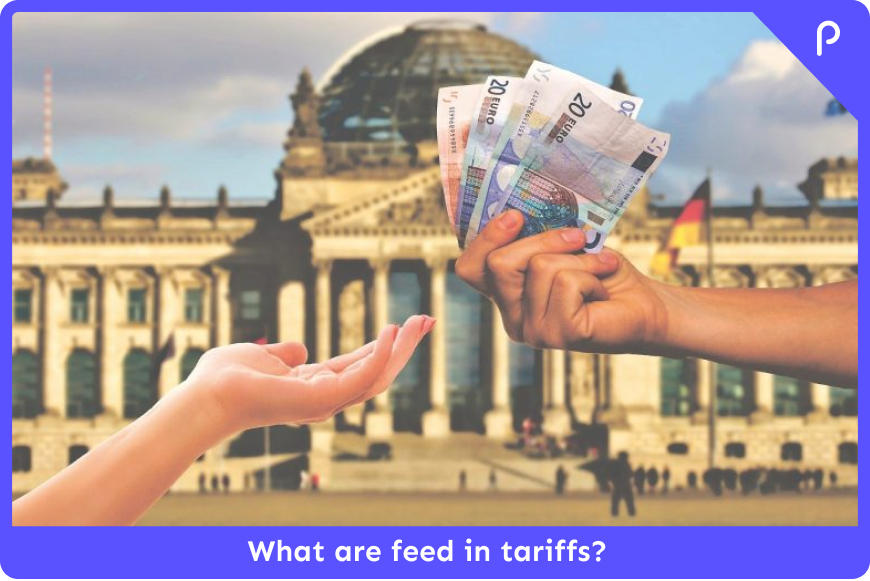Feed in tariffs: What are they?

Needing to switch up a few things in your life?
Take back control over your energy bills! Let us guide you on how to make big savings.
⭐️ Save now
The Feed in tariffs scheme, known as FIT, is a government initiative that allows you save money on energy bills by being paid for energy that you create and export to the National Grid. New applications to the scheme closed in April 2019 but let’s take a closer look at exactly how it worked: Homes that successfully applied for the scheme before 31 March 2019 are still eligible to receive payments for the energy they produce and feed back into the grid. However, if you missed the deadline to apply for the FIT scheme then don’t worry. It was replaced in January 2020 by the Smart Export Guarantee (SEG). Much of the way the new scheme works is the same as for the FIT so a lot of the information below will still be relevant.
Last update: November 2022
As you may have heard on the news, the UK energy market is currently under an immense amount of stress as a result of a global gas shortage driving up costs and putting several energy suppliers out of business. To learn more about this and stay updated on a daily basis you can read our page on the UK energy crisis.

What is a feed in tariff charge?
The Feed in Tariff charge was a levy imposed by the government to fund the FIT scheme, which was introduced in 2010 but came to an end for new applications in 2019 (although people who applied before this date are still eligible to make energy sales back to the grid).
The levy is collected from consumers. Each supplier is allocated its share of the overall FIT costs according to their market share. That means energy users in the UK will pay a small amount towards the FIT scheme to encourage more sustainable energy production.
What is the Feed in Premium?
Feed in Premium, or FIP, is a variant of the FIT scheme where electricity from renewable sources is sold back to the grid, with a premium on top of the market price for the power produced.
What is net metering?
Net metering is a billing mechanism that allows consumers who generate some of their own power to use that power anytime, instead of just when it is generated. This is very useful for renewable energy sources like wind and solar, which may produce more energy at some times than others but are difficult to store.
Net metering makes it easier for small scale energy producers to maintain a constant supply over the course of a year.
What is the Feed in Tariff UK?
It was a scheme run by the government that allowed small scale energy producers to sell their excess power back to the grid for a price. It ran from 2010 to 2019 and although still operational, has been replaced by the SEG.
The tariff was used to try and encourage the development of new technology and a higher uptake of small scale energy production. Any electricity fed into the grid also received an additional export tariff of 5.24p per kWh as of May 2020.
Who is the scheme for?
The scheme is aimed at small scale energy producers who make some of their own energy and often produce an excess which they cannot store. There are some qualifying requirements that include:
- Certification under the Microgeneration Certification Scheme and the REAL Code for systems up to 50 kW
- The use of specific metering standards
- Systems being installed no earlier than July 2009
What are the current Feed in Tariff rates?
The current Feed in Tariff rates as of March 2020 are 5.24p per unit of electricity. You are entitled to sell back half of the units of electricity you generate but you'll need an export meter if your installation is above 30kW. It is also possible to save money on your electricity bills for the energy you consume.
The key to understanding feed in tariffs
Feed in tariffs are not applicable to everyone for a number of reasons. You need to have applied to be part of the scheme before March 2019. You also need the means to produce some of your energy in a certified and grid approved way. However, the basic concept is simple.
A Feed in Tariffpays you for excess electricity generated by your system, and that is not used in your home. Under a net Feed in Tariff, a fee is paid for any energy that goes back into the grid from your property.
What is a power purchase agreement?
A Power Purchase Agreement, or PPA, is an arrangement where a company installs a green energy system on a homeowner's property, generally wind or solar. The homeowner then buys the electricity generated by the system at a fixed price but does not own the system itself.

Looking for an energy deal that best fits your needs?
Free Service
We analyse the market to find you the best fitting deal on the market.
More info
Benefits of Feed in Tariffs for small energy producers
There are a number of key benefits of the Feed in Tariff system both for small energy producers and society as a whole. These include:
- Increased drive for technological innovation
- Secure domestic energy supply
- Reduction of CO2 emissions
What is the best Feed in Tariff for solar panels?
Feed in Tariff payments were the same regardless of which electricity company paid them. This is because the rates were set by the government. However, you don’t have to use the same electricity company for your Feed in Tariff and your domestic electricity supplier.
Why are solar Feed in Tariffs so low?
The rates paid for solar power Feed in Tariffs were much lower than for other forms of renewable energy, as this table for 2019 shows:
| Energy type | Rate per kWh |
|---|---|
| Solar pv | 3.79 |
| Wind turbine | 8.24 |
| Hydropower | 8.03 |
| Micro CHP | 14.52 |
This was because solar was the easiest and most convenient to install. The equivalent of a new power station’s worth of energy generation was installed on the UK’s rooftops in the years after the scheme was introduced. So this meant rates were lower.
Can I change my Feed in Tariff supplier?
You are able to change your Feed in Tariff supplier. All energy companies with more than 250,000 customers had to supply a tariff, including: Avro Energy, British Gas, Bulb, Co-operative Energy, EDF Energy, Eon, Flow Energy, Npower, Octopus Energy, Ovo Energy, Scottish Power, Shell Energy, SSE, Utility Warehouse and Utilita. Some other small suppliers also joined the scheme.
How do I claim my Feed in Tariff?
Unless you have already signed up the scheme before March 2019 you are no longer eligible to benefit from it.
![]()
Is Feed in Tariff ending?
The scheme is continuing for eligible customers. However it has been replaced by the Smart Export Guarantee (SEG).
This will pay homes for excess renewable electricity they generate and put into the grid. Energy firms with more than 150,000 customers must offer a SEG tariff by the end of 2019.
The SEG differs from the FIT in the following ways:
- Payments will be based on measured export of electricity
- Companies set the rates of their SEG tariffs, the government set feed-in tariff rates
- You'll need a smart meter, or another meter which can measure half-hourly export to qualify
Who pays my Feed in Tariff?
The FIT was legally approved but rather than coming from the government, the tariffs were paid by the energy suppliers (over a certain size or voluntarily). When you registered you nominated which energy supplier you wanted to use, which was known as the licensee.
- Is Feed in Tariff income taxable?
Under an exemption, tariffs that received income for energy produced under the FITs (both the generation and the export tariff) were exempt from income tax. This was provided that the energy was for domestic consumption. So, the exemption does not apply to businesses.
Would you like more information on how to save on energy bills? Great! Check out these related articles
Looking to switch energy deals?Leave your phone number to request a call back from us!
Free Service
FAQ
What is a Feed in Tariff?
The Feed in Tariffs (FIT) scheme was a government initiative that pays you for energy you generate and export to the National Grid. It is now closed to new submissions.
How much is the Feed in tariff?
You'll get 5.24p per unit of electricity that you inject in the grid. You are allowed to self up to half of the units of electricity that you generate.
Is the FIT still going?
The scheme is now closed to new submissions but if you applied before March 2019 then you are still eligible for FIT payments.
Who was the FIT for?
It was aimed at small scale energy producers such as domestic wind and solar systems, and aimed to encourage more people to produce energy in a domestic setting.
Who pays the Feed in Tariff?
The tariffs are paid by the energy suppliers, with those with more than 250,000 customers legally obliged to contribute and some smaller companies doing so voluntarily.
Updated on 11 Nov, 2022
Alexander Striano
Energy Specialist & Copywriter
Alex joined the papernest team as a SEO Project Manager Assistant for Broadband Plans. He has developed a real expertise on connectivity topics and works on delivering the best possible content to help you navigate your broadband in and outside your home.
Alex joined the papernest team as a SEO Project Manager Assistant for Broadband Plans. He has developed a real expertise on connectivity topics and works on delivering the best possible content to help you navigate your broadband in and outside your home.
William Dautel
Website manager
William is a content marketing specialist. After 3 years writing brand strategies he joined papernest to help create the best content to help people handle and save on their utilities.
William is a content marketing specialist. After 3 years writing brand strategies he joined papernest to help create the best content to help people handle and save on their utilities.

